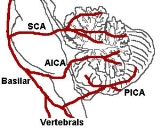
Anterior inferior cerebellar artery
Encyclopedia
The anterior inferior cerebellar artery (AICA) arises from the basilar artery
at the level of the junction between the medulla oblongata
and the pons
in the brainstem. It passes backward to be distributed to the anterior part of the undersurface of the cerebellum
, anastomosing
with the posterior inferior cerebellar
branch of the vertebral artery
. It supplies the anterior inferior quarter of the cerebellum.
It also gives off the labyrinthine artery in most cases; however, the labyrinthine artery can emerge as a branch of the basilar artery
in others.
, also known as AICA syndrome. The symptoms include sudden onset vertigo and vomiting, nystagmus
, falling to the side of the lesion (due to damage to vestibular nuclei
), ipsilateral loss of sensation of the face (due to damage to principal sensory trigeminal nucleus), ipsilateral facial paralysis (due to damage to the facial nucleus) and ipsilateral hearing loss and tinnitus (due to damage to the cochlear nuclei
).

Basilar artery
In human anatomy, the basilar artery is one of the arteries that supplies the brain with oxygen-rich blood.The two vertebral arteries and the basilar artery are sometimes together called the vertebrobasilar system, which supplies blood to the posterior part of circle of Willis and anastomoses with...
at the level of the junction between the medulla oblongata
Medulla oblongata
The medulla oblongata is the lower half of the brainstem. In discussions of neurology and similar contexts where no ambiguity will result, it is often referred to as simply the medulla...
and the pons
Pons
The pons is a structure located on the brain stem, named after the Latin word for "bridge" or the 16th-century Italian anatomist and surgeon Costanzo Varolio . It is superior to the medulla oblongata, inferior to the midbrain, and ventral to the cerebellum. In humans and other bipeds this means it...
in the brainstem. It passes backward to be distributed to the anterior part of the undersurface of the cerebellum
Cerebellum
The cerebellum is a region of the brain that plays an important role in motor control. It may also be involved in some cognitive functions such as attention and language, and in regulating fear and pleasure responses, but its movement-related functions are the most solidly established...
, anastomosing
Anastomosis
An anastomosis is the reconnection of two streams that previously branched out, such as blood vessels or leaf veins. The term is used in medicine, biology, mycology and geology....
with the posterior inferior cerebellar
Posterior inferior cerebellar artery
The posterior inferior cerebellar artery , the largest branch of the vertebral artery, is one of the three main arterial blood supplies for the cerebellum, part of the brain...
branch of the vertebral artery
Vertebral artery
The vertebral arteries are major arteries of the neck. They branch from the subclavian arteries and merge to form the single midline basilar artery in a complex called the vertebrobasilar system, which supplies blood to the posterior part of the circle of Willis and thus significant portions of the...
. It supplies the anterior inferior quarter of the cerebellum.
It also gives off the labyrinthine artery in most cases; however, the labyrinthine artery can emerge as a branch of the basilar artery
Basilar artery
In human anatomy, the basilar artery is one of the arteries that supplies the brain with oxygen-rich blood.The two vertebral arteries and the basilar artery are sometimes together called the vertebrobasilar system, which supplies blood to the posterior part of circle of Willis and anastomoses with...
in others.
Clinical significance
Occlusion of AICA results in lateral pontine syndromeLateral pontine syndrome
A lateral pontine syndrome is a lesion which is similar to the Lateral medullary syndrome, but because it occurs in the pons, it also involves the cranial nerve nuclei of the pons.-Causes:...
, also known as AICA syndrome. The symptoms include sudden onset vertigo and vomiting, nystagmus
Nystagmus
Nystagmus is a condition of involuntary eye movement, acquired in infancy or later in life, that may result in reduced or limited vision.There are two key forms of Nystagmus: pathological and physiological, with variations within each type. Nystagmus may be caused by congenital disorders,...
, falling to the side of the lesion (due to damage to vestibular nuclei
Vestibular nuclei
The vestibular nuclei are the cranial nuclei for the vestibular nerve.In Terminologia Anatomica they are grouped in both the pons and medulla.-Subnuclei:There are 4 subnuclei; they are situated at the floor of the fourth ventricle....
), ipsilateral loss of sensation of the face (due to damage to principal sensory trigeminal nucleus), ipsilateral facial paralysis (due to damage to the facial nucleus) and ipsilateral hearing loss and tinnitus (due to damage to the cochlear nuclei
Cochlear nuclei
The cochlear nuclei are two heterogeneous collections of neurons in the mammalian brainstem that receive input from the cochlear nerve, which carry sound information from the cochleae...
).
External links


